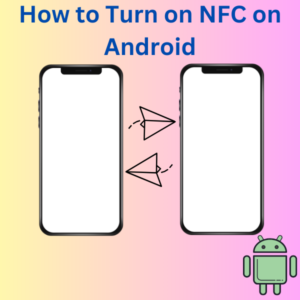NFC, or Near Field Communication technology, allows Android devices to communicate with each other or other NFC-supported devices nearby. This feature makes it easy to transfer data, use contactless payments, and interact with NFC tags—all without needing a physical connection. Whether you’re setting up Google Pay, using Samsung Pay, or transferring data between Android phones, turning on NFC is a simple process. Here’s how to do it.

Steps to Turn On NFC on Android
Here’s a step-by-step guide on how to enable NFC on your Android device:
- Open the Settings App
Begin by accessing your device’s main settings. You can typically find the Settings app in your app drawer or by swiping down and tapping the gear icon in your Notification panel. - Navigate to Connections or Connected Devices
Select Connections, Connected Devices, or Connection Preferences depending on your Android device model. This is where you can manage your device’s various wireless and connection settings. - Look for NFC or Near Field Communication
Scroll down to find NFC, which may be labeled as Near Field Communication. On some Android phones, this option might also be within More Connection Settings or NFC and Contactless Payments. - Toggle NFC On
Use the toggle switch next to NFC to activate it. Once enabled, you should see options to further customize how NFC works, such as enabling Android Beam, a feature that allows you to move data between NFC-enabled devices by simply touching them together. - Set Up Contactless Payments (Optional)
If you’re interested in using NFC for mobile payments, you may need to select your preferred mobile payment service, like Samsung Pay. This step may vary slightly depending on your Android device, but you can usually find payment options within the NFC settings.
That’s it! You’ve successfully turned on NFC on your Android phone. Now you can easily make contactless payments, read NFC tags, and move data.
Frequently Asked Questions (FAQs)
Q: What is NFC?
A: NFC technology stands for Near Field Communication, a short-range wireless technology that allows compatible devices to communicate when in close proximity. It’s commonly used for contactless payments, data transfers, and interacting with NFC tags.
Q: Why would I want to enable NFC on my Android phone?
A: Enabling NFC lets you use features like contactless payments, data transfers, and reading NFC tags. It’s a secure and convenient way to perform various tasks by tapping your device.
Q: How can I check if my Android phone supports NFC?
A: To check if your device supports NFC, go to Settings and look for NFC in the Connections or Connected Devices section. If you see an NFC option, your device is equipped with this technology. You can also refer to your device’s specifications in the Google Play Store or the manufacturer’s website.
Q: Can I turn NFC off after using it?
A: Yes, you can easily disable NFC by toggling the NFC switch off in the Settings app. This is useful if you only want to use NFC for specific tasks and prefer to keep it off otherwise.
Q: Is NFC secure?
A: NFC is generally secure because it works over very short distances, usually just a few centimeters. This close proximity requirement adds a layer of security, making it a trusted method for NFC payments and data transfers.
Q: Do iOS devices have NFC?
A: Yes, iOS devices also support NFC, although their use may be more restricted compared to Android devices. iPhones, for example, can use NFC for Apple Pay and reading certain types of NFC tags.
Q: Can older Android models use NFC?
A: Many older Android phone models support NFC, but it varies by device. Check your phone’s specifications to confirm if it includes NFC capability.
Q: Can I use NFC to move data between Android devices?
A: Absolutely! Android Beam, now deprecated but still available on some devices, used to allow for easy data transfer between NFC-enabled Android devices. You can still use NFC for transferring data through other apps like Google Pay or file-sharing apps that support NFC.
